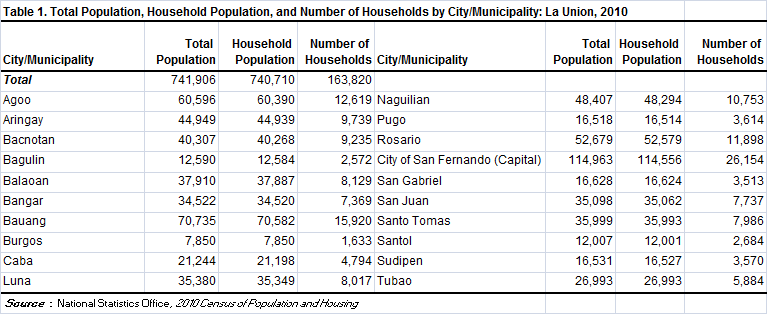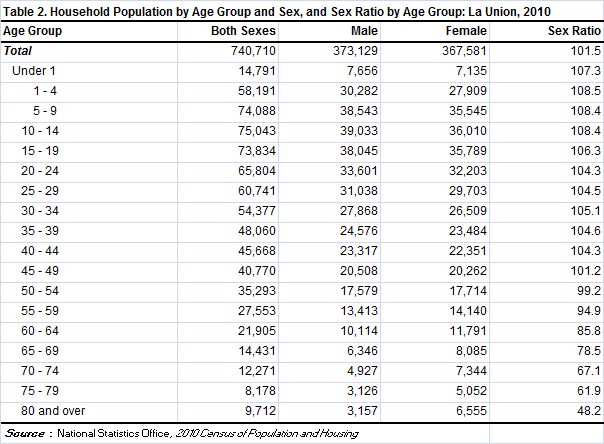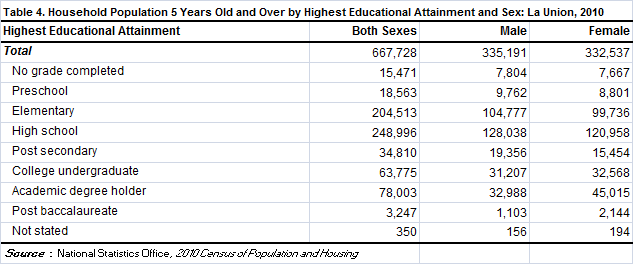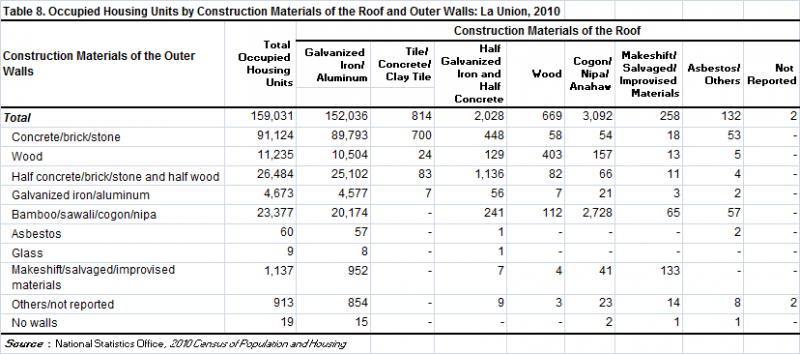Population of La Union increased at the rate of 1.21 percent annually
Based on the 2010 Census of Population and Housing (CPH), the province of La Union posted a total population of 741,906 persons as of May 1, 2010. This is larger by 83,961 persons compared to its total population of 657,945 persons counted in the 2000 CPH. The increase in the population count from 2000 to 2010 translated to an average annual population growth rate (PGR) of 1.21 percent. This is lower than the 1.83 percent annual PGR of the province between the census years 1990 and 2000.
If the average annual PGR recorded at 1.21 percent during the period 2000 to 2010 continues, the population of La Union would double in 58 years.
Fifty years ago, the population of La Union was only 293,330 persons. This population size is more than one third of the population in the 2010 CPH.
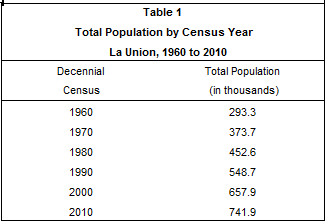
City of San Fernando was the most populous
Among the lone city and 19 municipalities comprising the province of La Union, the City of San Fernando, the provincial capital, was the most populous with a population size making up 15.5 percent of the total provincial population. The municipality of Bauang was second with 9.5 percent share, followed by the municipalities of Agoo (8.2 percent), Rosario (7.1 percent), Naguilian (6.5 percent), and Aringay (6.1 percent). The rest of the municipalities contributed less than 6.0 percent each.
The least populated area was the municipality of Burgos with 1.1 percent share to the total population of the province. It was also the least populated area in 2000.

Sex ratio was 102 males per 100 females
Of the 740,710 household population in 2010, males accounted for 50.4 percent while females comprised 49.6 percent. These figures resulted in a sex ratio of 102 males for every 100 females, the same sex ratio recorded in 2000.
Median age increased to 25.7 years
In 2010, the median age of the population of the province was 25.7 years, which means that half of the population was younger than 25.7 years. This is higher than the median age of 22.5 years that was recorded in 2000.
Moreover, about three in every 10 persons (29.9 percent) were under 15 years old. Children aged 10 to 14 years (10.1 percent) comprised the largest age group, followed closely by those in the age groups 5 to 9 years (10.0 percent) and 15 to 19 years (9.9 percent). Males outnumbered females in the age groups 0 to 49 years. On the other hand, there were more females than males in the older age groups (50 years and over).

More than three fifths of the population were of voting age
The voting-age population (18 years and over) accounted for 64.0 percent of the household population of the province in 2010, up from 58.6 percent in 2000. There were more females (50.5 percent) than males (49.5 percent) among the voting-age population.
In 2010, the young dependents (0 to 14 years) comprised 30.0 percent of the household population while the old dependents (65 years and over) posted a share of 6.0 percent. The working-age population (15 to 64 years) accounted for the remaining 64.0 percent.
The overall dependency ratio was 56, which indicates that for every 100 working-age population, there were about 56 dependents (47 young dependents and nine old dependents). This ratio is lower than the dependency ratio in 2000, which was recorded at 68 dependents per 100 working-age population (59 young dependents and nine old dependents).
There were more males than females among the never-married persons
Of the household population 10 years old and over, 46.4 percent were married while 41.6 percent were never married. The rest of the population were categorized as follows: widowed (5.4 percent), common-law/live-in marital arrangement (5.3 percent), and divorced/separated (1.2 percent).
Among the never-married persons, 54.7 percent were males while 45.3 percent were females. For the rest of the categories for marital status, the females outnumbered the males.
More females had attained higher levels of education
Of the household population aged five years and over, 30.6 percent had attended or completed elementary education, 37.3 percent had reached or finished high school, 9.6 percent were college undergraduates, and 11.7 percent were academic degree holders. Among those with an academic degree, the females (57.7 percent) outnumbered the males (42.3 percent). Similarly, more females (66.0 percent) than males (34.0 percent) had pursued post baccalaureate courses.
Persons with disability comprised 1.8 percent of the population in the province
In 2010, around 13,200 persons or 1.8 percent of the 740,710 household population had a disability. This proportion of persons with disability (PWD) is higher than the proportion in 2000, which was 1.5 percent of the 657,226 household population of the province during that year. The number of PWD for the same year was around 10,100.
There were more females than males among those with functional difficulty
Of the 667,728 household population five years and over, 3.3 percent (22,303 persons) had at least one type of functional difficulty either in seeing, hearing, walking or climbing steps, remembering or concentrating, self-caring (bathing or dressing), or communicating. There were more females (54.9 percent) than males (45.1 percent) among those persons with at least one type of functional difficulty.
Moreover, of the total 22,303 persons aged five years and over with at least one type of functional difficulty, 63.1 percent reported difficulty in seeing, even if wearing eyeglasses. There were 26.5 percent who had difficulty in walking or climbing steps; 24.2 percent had difficulty in hearing, even if using a hearing aid; 16.0 percent had difficulty in remembering or concentrating; 13.0 percent had difficulty in communicating; and 11.6 percent had difficulty in self-caring (bathing or dressing).
Female overseas workers outnumbered their male counterparts
Of the 593,640 household population 10 years old and over in La Union, 4.1 percent (or 24,531 persons) were overseas workers. Female overseas workers outnumbered their male counterparts as they comprised 54.9 percent of all the overseas workers from this province. Overseas workers aged 45 years and over made up the largest age group, comprising 21.9 percent of the total overseas workers from this province in 2010, followed by the age groups 30 to 34 years (19.7 percent), 25 to 29 years (18.6 percent) and 35 to 39 years (17.1 percent).
Average household size was 4.5 persons
The number of households in 2010 was recorded at 163,820, higher by 36,241 households compared with the 127,579 households posted in 2000. The average household size in 2010 was 4.5 persons, lower than the average household size of 5.2 persons in 2000.

There were 103 households per 100 occupied housing units
A total of 159,031 occupied housing units were recorded in La Union in 2010. This translates to a ratio of 103 households for every 100 occupied housing units, with 4.7 persons per occupied housing unit. In 2000, there were 103 households per 100 occupied housing units and 5.3 persons per occupied housing unit.
Occupied housing units with outer walls and roofs made of strong materials increased
In 2010, 57.3 percent of the occupied housing units in the province had outer walls made of concrete/brick/stone, up from 41.2 percent in 2000. The proportion of occupied housing units with outer walls made of galvanized iron/aluminum also increased from 2.5 percent in 2000 to 2.9 percent in 2010. Meanwhile, majority (95.6 percent) of the occupied housing units in 2010 had roofs made of galvanized iron/aluminum. This is higher than the proportion recorded in 2000 at 92.2 percent.
Majority of the households lived in lots that they owned or amortized
In 2010, of the total 163,820 households, 72.9 percent owned or amortized the lots that they occupied. The corresponding figure in 2000 was lower at 61.6 percent.
Moreover, more than one fifth (21.4 percent) of the households occupied lots which were rent-free but with consent of the owner, 4.7 percent rented the lots that they occupied while 0.7 percent occupied lots which were rent-free but without consent of the owner.
